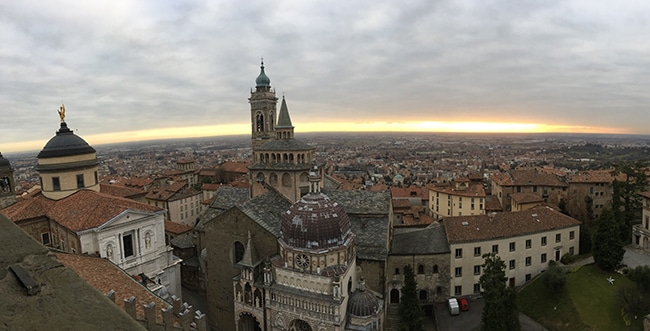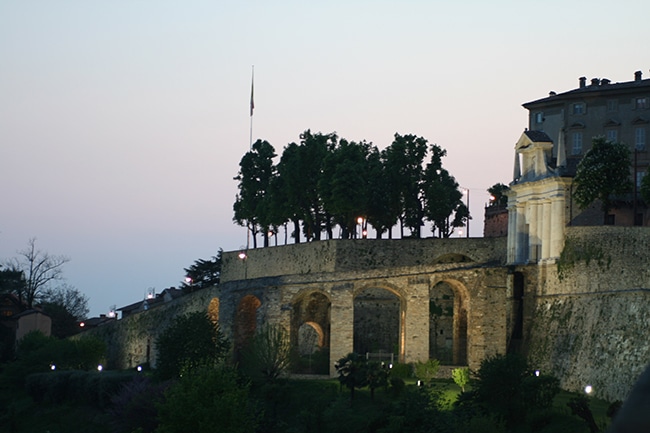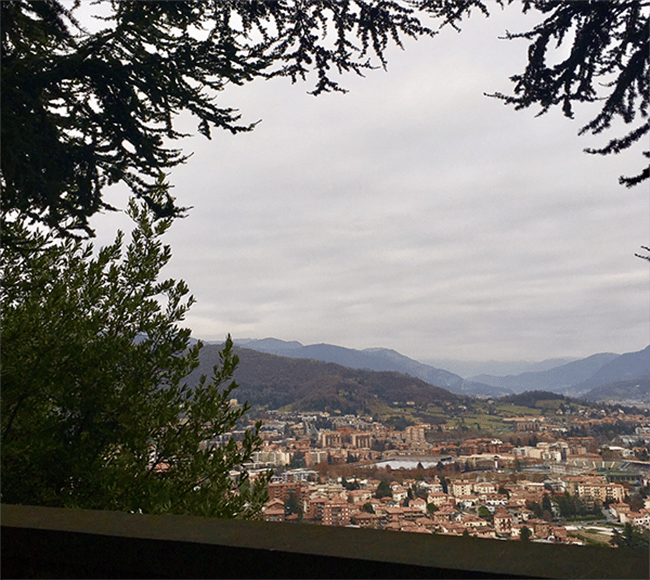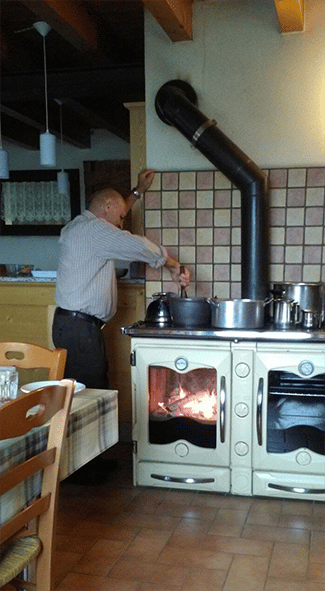Flying over the extreme North of the Italian peninsula, where the peaks of the Alps mellow in luxuriant hills that stand as the last bastions to the vastness of the Po Valley, the city of Bergamo is located like a pearl of undeniable beauty that even the most distracted observer can’t ignore.
The invitation to visit begins with history. Known to be the “Città dei Mille“ (City of the Thousand) because of the number of volunteers from Bergamo that took part in the expedition lead by Giuseppe Garibaldi, crucial episode for Italy’s Unification (1861), Bergamo preserves historical nucleuses, very ancient, whose major trace lies in the part of the town erected on the hills, called “Città Alta” (Upper Town).

Città Alta has all the characteristics of a medieval city, surrounded by bastions constructed in the 16th century during the Venetian dominion. Those same walls, built in defense of the city, which strategic position made it a valuable place throughout the centuries, seem still today sentinels protecting a treasure made of noble palaces, peaking towers, plazas, fountains and churches that can be reached only through paved roads, for the most part forbidden to the city traffic.
The town is so dense of point of interests, that a single day visit wouldn’t be enough. But if you don’t have much time, go to the center of Piazza Vecchia (Old Plaza) and let your gaze slowly skim the countless beauties surrounding, such as the Fontana Contarini (Contarini Fountain), the Torre Civica (City Tower), the Palazzo della Ragione (the palace of the 12th century town hall ), Palazzo Nuovo (The New Palace, location of the Civic Library) and some historical, culinary places. From the center of the plaza, the Duomo of Sant’Alessandro (The Cathedral of Saint Alexander), the Cappella Colleoni (The Colleoni’s Chapel, that hosts the funeral monuments of medieval warlord Bartolomeo Colleoni), the Battistero (Baptistery) and the Basilica of Santa Maria Maggiore (Cathedral of Saint Mary) can be seen too.
The City Tower is commonly called Campanone (Big Bell) because of, indeed, its bell that still today, at ten o’clock at night, strikes a hundred times. In the past, this sound announced the night closing of the four gates of the bastions, the only entry points in the city. If the wind is favorable, the sound of the bell can also be heard in the closest villages of the province of Bergamo too, notoriously very tied to the city.

While visiting the Basilica of Santa Maria Maggiore, you can witness many artistic marvels: you could in fact admire the marquetry illustrating biblical scenes made with wood in various colors, based of Lorenzo Lotto’s drawings, and an impressive, Baroque confessional sculpted by Andrea Fantoni. The church hosts the grave of Gaetano Donizetti, a famous composer born in Bergamo, that also gives the name to the nearby conservatory, since music has always been part of the city culture.
But if the charm of history and the arts hasn’t mitigated your travel greed, let yourselves get involved in the natural landscape of the Prealpi Orobiche (Bergamasque Prealps) and the valleys, that not only can be admired from the many city towers, or by climbing to the top of Colle di San Vigilio (Hill of Saint Virgil, where the namesake castle lies), but can also be enjoyed while strolling along the bastions boulevards. The different seasons of the year lend the landscape colors and lights always different.
Personally, I suggest a visit in the fall, when, on a clear day, the surrounding nature, the small orchards, and the nearest mountain peaks, give to the eyes a wide range of colors. In a day when the fog envelops the lower part of the city, instead, the surreal landscape will create the illusion of standing on a cloud.

Walking on the paved streets, along the bastions, or even reaching Città Alta by foot, through the staircases that connect it to the lower part of the city (perhaps using the characteristic funicular for the descend), will certainly stimulate your appetite.
And if the list of what you can taste, in the most renowned restaurants or in the most modern street food kiosks, deserves a blog of his own, I can’t avoid mentioning the casonsei: ravioli with a stuffing that, in its most traditional recipe, requires crumbed bread, salami mince, beef stuffed meat and Grana Padano cheese.

The polenta taragna from Bergamo, made from milled corn and cheeses, fulfills a place of honors in the local cuisine for various reasons. The first being that the farming of corn is still alive in the territory, with certain selected varieties, also of ancient tradition. Moreover, the cheeses utilized for the preparation of this dish (some of protected origin – D.O.P.), come from the alpine pastures in the area. Lastly, polenta taragna can constitute a main course of its own, that satisfies even the most demanding mouth. But one must be careful: the recipe can appear simple, but only with the right ingredients, a good pot, the typical tarel (polenta stick), and the ability to mix it at the right times and in the right ways to avoid clumps, one can reach the perfect result.
The “Città Bassa” (Lower Town), the residential area that stands at the foot of the hills, has withstood through the years a more modern urbanization. But this part of city doesn’t lack reasons to visit it: the historical borghi (suburbs) that well harmonize with the most recent constructions, the art collections guarded in the Carrara Academy, the typical Portici del Sentierone (a boulevard coasted by porticoes), the Chiesa di San Bartolomeo (Church of Saint Bartholomew), the Donizetti Theater, the Propilei (typical constructions with a colonnade on top of a huge staircase).
The shopping, that you easily can do in little, historical shops or in big shopping malls just outside the city, and the convenient airport complete the masterpiece!
If you are not yet satisfied with the reasons I’ve given you to visit the City of the Thousand, I’ll leave one more to you, a famous quote that describes Bergamo as “… the most beautiful corner of Italy, one of the many, small surprises and joys that makes travelling worthwhile.” (H. Hesse, 1926).
And I couldn’t agree more, because I was born in Bergamo.
Pictures by Luca and Miriam Cortinovis.
Translation by Miriam Cortinovis.
Contact ICAP for information on our Italian Citizenship Services, fees or how to place an order (si puo’ comunicare in Italiano).
